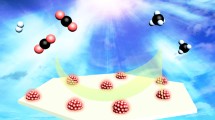Abstract
Methanation of CO2 by H2 can be in the future an important reaction to store the surplus of renewable electricity during production peaks. The catalytic thermal CO2 methanation (the Sabatier reaction) can be carried out at temperatures above 250 °C using Ni supported on silica-alumina (Ni/SiO2–Al2O3). Recently it has been observed that this exothermic reaction can be promoted by solar light irradiation of Ni/SiO2–Al2O3 at initial near ambient temperatures. In the present work we provide a study of the influence of the initial temperature on the photoassisted Ni/SiO2–Al2O3 methanation of CO2, under conditions in which the dark reaction is not observed. An increase of the photoassisted methanation rate with the initial temperature in the range from ambient to 150 °C has been observed. The reaction kinetics for lower initial temperatures exhibited an induction period not observed for reactions performed at higher temperatures. The results are discussed in terms of the operation of plasmon photo activation in which the energy of photons is thermalised in a confined space of the active nanoparticles leading to locally high temperatures and the simultaneous photogeneration of electrons and positive holes.





Similar content being viewed by others
References
Hammarstrom L, Hammes-Schiffer S (2009) Artificial photosynthesis and solar fuels. Acc Chem Res 42:1859–1860
Schlögl R (2015) The revolution continues: energiewende 2.0. Angew Chem Int Ed 54:4436–4439
Herron JA, Kim J, Upadhye AA, Huber GW, Maravelias CT (2015) A general framework for the assessment of solar fuel technologies. Energy Environ Sci 8:126–157
Hoekman SK, Broch A, Robbins C, Purcell R (2010) CO2 recycling by reaction with renewably-generated hydrogen. Int J Greenh Gas Control 4:44–50
Hoch LB, Wood TE, O’Brien PG, Liao K, Reyes LM, Mims CA, Ozin GA (2014) The rational design of a single-component photocatalyst for gas-phase CO2 reduction using both UV and visible light. Adv Sci 1:1400010–1400013
Sastre F, Puga AV, Liu L, Corma A, Garcia H (2014) Complete photocatalytic reduction of CO2 to methane by H2 under solar light irradiation. J Am Chem Soc 136:6798–6801
Melsheimer J, Guo W, Ziegler D, Wesemann M, Schlögl R (1991) Methanation of carbon dioxide over Ru/titania at room temperature: explorations for a photoassisted catalytic reaction. Catal Lett 11:157–168
O’Brien PG, Sandhel A, Wood TE, Jelle AA, Hoch LB, Perovic DD, Mims CA, Ozin GA (2014) Photomethanation of gaseous CO2 over Ru/silicon nanowire catalysts with visible and near-infrared photons. Adv Sci 1:1400001–1400007
Ghuman KK, Wood TE, Hoch LB, Mims CA, Ozin GA, Singh CV (2015) Illuminating CO2 reduction on frustrated Lewis pair surfaces: investigating the role of surface hydroxides and oxygen vacancies on nanocrystalline In2O3−x(OH)y. Phys Chem Chem Phys 17:14623–14635
Wei W, Jinlong G (2011) Methanation of carbon dioxide: an overview. Front Chem Sci Eng 5:2–10
Scaiano JC, Stamplecoskie K (2013) Can surface plasmon fields provide a new way to photosensitize organic photoreactions? Custom applications. J Phys Chem Lett 4:1177–1187
Fasciani C, Alejo CJB, Grenier M, Netto-Ferreira JC, Scaiano JC (2011) High-temperature organic reactions at room temperature using plasmon excitation: decomposition of dicumyl peroxide. Org Lett 13:204–207
Leadbeater NE (2010) Microwave heating as a tool for sustainable chemistry. CRC Press, Boca Raton
Acknowledgments
Financial support by the Spanish Ministry of Economy and Competitiveness (Severo Ochoa and CTQ-2012-32315) and Generalidad Valenciana (Prometeo 2013-019) is gratefully acknowledged.
Author information
Authors and Affiliations
Corresponding author
Rights and permissions
About this article
Cite this article
Albero, J., Garcia, H. & Corma, A. Temperature Dependence of Solar Light Assisted CO2 Reduction on Ni Based Photocatalyst. Top Catal 59, 787–791 (2016). https://doi.org/10.1007/s11244-016-0550-x
Published:
Issue Date:
DOI: https://doi.org/10.1007/s11244-016-0550-x




